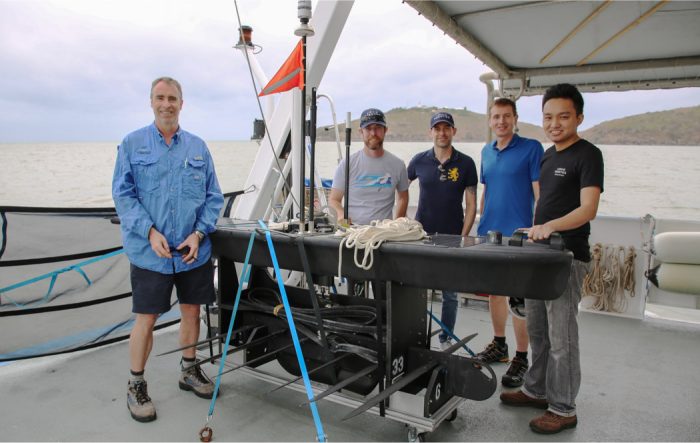
Image: Australian Institute of Marine Science
A wave and solar powered autonomous ocean vehicle recently completed a trial deployment at Australia’s Great Barrier Reef, where it gathered data to help assess the health of coral reefs and ecosystems.
The seven‐day trial of Liquid Robotics’ Wave Glider saw the craft cover 200 nautical miles of the central Great Barrier Reef, part of a five‐year joint research agreement between the Australian Institute of Marine Science (AIMS) and Liquid Robotics’ parent company, Boeing.
“We are impressed with the number of different measurements it could conduct at the same time and its ability to transmit the data back to our base immediately and reliably while navigating and performing its mission,” said AIMS head of Data and Technology Innovation, Dr. Lyndon Llewellyn.
The Wave Glider’s payload can include a weather station, cameras and hydrophone, plus sensors measuring wave height and direction, water temperature, pressure, dissolved oxygen, salinity, pH, chlorophyll levels, currents and contaminants.
Propulsion of the Wave Glider is achieved primarily through harnessing wave energy. The deck of the craft is covered with solar panels (up to 180 watts capacity) that charge a battery bank of 0.9kWh – 6.8kWh capacity. The batteries are used for powering sensors and an additional propulsion system.
It’s no speed demon, traveling at 1 – 3 knots, but what Wave Glider lacks in speed, it makes up for in endurance; with missions of up to a year possible.
Liquid Robotics’ Wave Glider fleet has so far racked up more than 1.4 million nautical miles. Some of the vessels have successfully endured hurricanes, ten-metre-high seas and even shark attacks.
The greatest distance covered by a Wave Glider in a single mission to date is 9,380 nautical miles; achieved during a journey across the Pacific Ocean from San Francisco, USA, to Lady Musgrave Island in Queensland. It was during this mission that the Wave Glider set a Guinness World Record for the longest journey by an unmanned autonomous surface vehicle.
With the Wave Glider being able to spend months at sea, it reduces risk to personnel and frees up human resources to focus on science, rather than the logistics involved with collecting data.
“The demonstration proves how autonomous systems like our Wave Glider can improve upon human‐based environmental data collection methods while also being safe and affordable,” said Boeing Autonomous Systems vice president and general manager Chris Raymond.
Founded in 2007, Liquid Robotics was acquired by Boeing last year.
Australia’s Great Barrier Reef is the largest living structure on Earth. It’s facing a number of threats, including rising ocean temperatures driven by climate change. A report published in June by Deloitte estimated the Great Barrier Reef’s economic, social and icon asset value to be $56 billion.

 RSS - Posts
RSS - Posts



Speak Your Mind